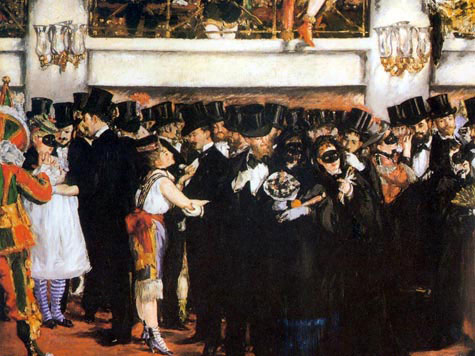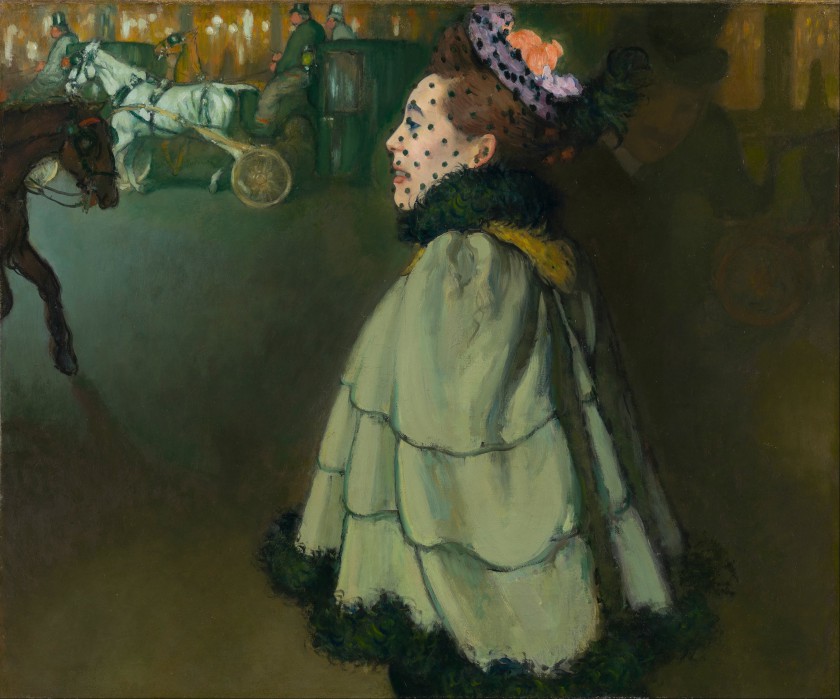 |
| Edouard Manet, Bal masqué à l'Opéra, 1873 |
I am still digesting the Splendour and Misery exhibition at the
Musée d’Orsay. I don’t know whether to celebrate or commiserate its staging as one
of the major exhibitions in Paris this fall. In the first text panel on entry
into the exhibition, there is a very bold pronouncement of how surprising it is
that men were the ones to paint images of prostitutes in the period (1850-1910).
This lack of self-consciousness is indicative of the entire exhibition. Of
course, it is only men who painted prostitutes because the kind of paintings
the Musée d’Orsay exhibits are all made by men: paintings that demonstrate the
coincidence of the rise of prostitution and high modernism. But then, I wonder
why I was so surprised, because experimental, amateur and private images made
by women in the late 19th century are not going to bring in tourist
euros.
 |
| Louis Anquétin, Femme sur les Champs Elysée la nuit, 1889-93 |
For all the
paintings by French fathers of modernism, there were some interesting photographs
and behind closed curtains, some glorious daguerrotypes and early films
depicting and advertising sex. These images, like many of the paintings by Musée
d’Orsay favorites--Manet, Degas, Forain, Béraud, and Anquetin--were provocative
and interesting for many reasons, few of which were raised by the exhibition. In
spite of its title and publicity, the exhibition is staged as a history of the
rise of prostitution in France. Thus,
paintings and some photographs are used to document the life of prostitutes “in
the modern age.” In the couple of rooms that draw attention to the coincidence
of technological modernity and prostitution, the paintings are posed as
documents of historical events going on outside of painting. Thus, Louis
Anquétin’s Femme sur les Champs Elysée la
nuit and other paintings in the L’Heure
du Gaz room, show that prostitution flourished at night under city street lights.
 |
| Henri Toulouse Lautrec, Au Moulin Rouge, 1892-95 |
Little is said of the complexity of representation found in significant paintings that critique this world. For example, Manet’s Bal masqué à l’Opéra documents the habit of poorer women to find prospective husbands and benefactors at the opera. Manet’s painting is an exquisite representation of class and gender visualized across space, in gesture, costume and in framing, as well as brushtroke and the sweep of the crowd in the composition. All of the replication of the commodification of sex and female sexuality for sale by the complex transformation of Manet’s modernist canvas is lost in an exhibition that prefers to titillate than understand modernist art.
 |
| Louis Béraud, L'Attente, vers 1885 |
Also troubling
about the exhibition is its framing of women as victims of modernity, suffering
the social transformations that brought the commodification of sex and men’s
desire to exploit women’s bodies for pleasure. Modernity is also about pleasure
having an expression or needing to be expressed. What’s missing altogether is
any appreciation, let alone, understanding of the different ways that the male
artist represented the prostitute. Béraud’s placement of the faceless woman in L’Attente, vers 1885, as an object to be
looked at by the spectator as well as the man in the painting is given the
exact same status of historical document as Manet’s Irma Brunner, 1880. Manet’s portrait is painted with a face, in
profile, given a dignity and an identity equal to that of a noblewoman. And
Manet’s empathy for La Prune, 1875 in
sumptuous pink, in closeup, bored, beautiful but trapped and framed by the
devices around her gives her an identity, a personality and a fate, that is not
solely dependent on the men who might be watching her. Looking and who looks at
who, or how the woman is positioned within the frame is so different from
painting to painting. However, this is completely effaced by an exhibition that
is interested in using paintings to tell a story.
 |
| Edouard Manet, La Prune, 1878 |
Even without
going into the theoretical issues of vision and visuality that went hand in
hand with prostitution and the transformation to representation in modernity,
there are other elements of the paintings that are glossed over. The changing definitions
of portraiture that see Toulouse Lautrec’s images of women turned away from him
and the viewer, the portraiture of everyday people, how prostitution was also
all about performance and parading of sexuality -- going hand in hand with costumes,
shopping, the changing identity of men in modern society, questions of
spectacle, disconnection, all of which are articulated through looks as well as
dress, makeup, lights, performance. These levels of complexity are not
foregrounded by the exhibition
Of course, it’s
always a treat to see so many great paintings on display in one space. And
there are many in this exhibition brought from all over the world. However, in
direct proportion to the apparent liberation and equality of women apparently intended
by the museum, there is also a persistent oppression and devaluation of women. Of
course, we can’t do anything about what painters and photographers in the
late-nineteenth century saw on their streets, or how they saw it, but surely we
are compelled to educate the next generation of women of the prejudices they
face on a daily basis? An exhibition that uses paintings of prostitution to tell
a story from the perspective of the men who wrote it--but not always the
painters who painted it--does not take responsibility for that education.
No comments:
Post a Comment